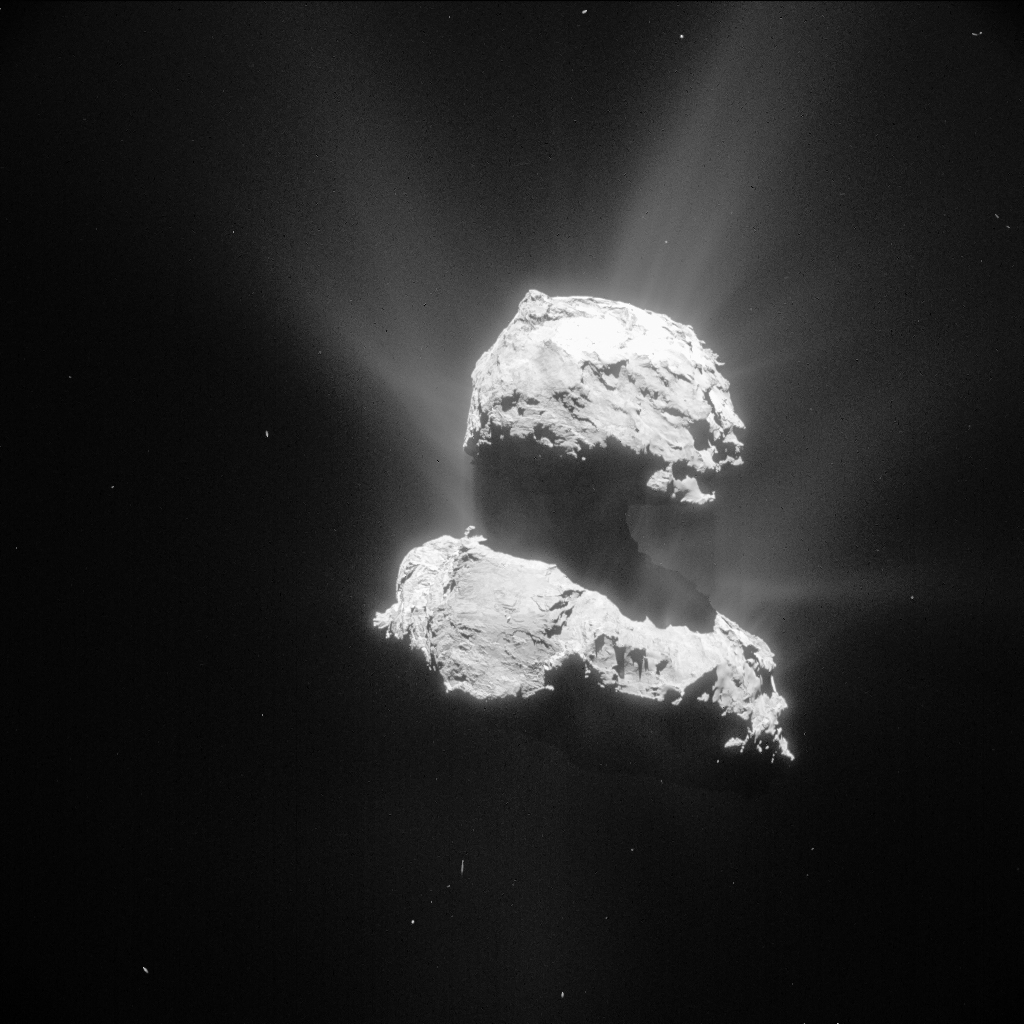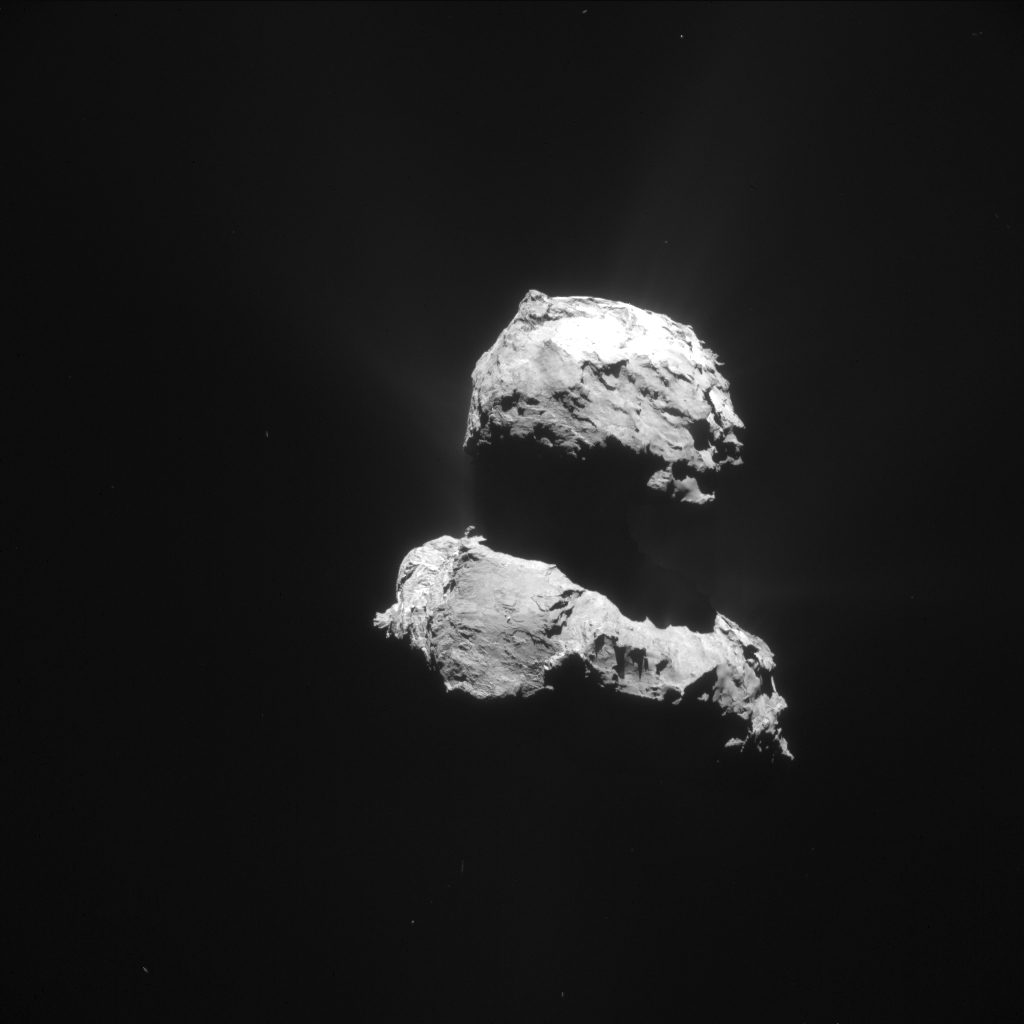This image of Comet 67P/Churyumov-Gerasimenko was taken on 26 April and not only presents an incredible view of the comet’s activity, but also shows off some interesting new views of the comet’s nucleus.

Comet 67P/C-G on 26 April 2015 from a distance of 98 km. The image has been processed to bring out details of the comet’s activity. Credits: ESA/Rosetta/NAVCAM – CC BY-SA IGO
The image was taken by Rosetta’s NAVCAM from a distance of 98 km from the comet centre. The scale at this distance is 8.4 m/pixel and the image measures about 8.6 km across.
One eye-catching region lies in the foreground of the comet’s large lobe, which appears as a smoother swath of material sandwiched between more rugged surrounds. This is also evident in an image taken last month from a different angle, and as such it is interesting to compare the two.
Perhaps even more captivating is the intricate pattern of activity streaming in all directions from both the small and the large lobe. While many distinct bands of dust extend towards the edge of the field of view, more diffuse regions of activity can be made out close to the nucleus. This makes for a particularly beautiful scene along the boundary between the shadowed and sunlight region on the large lobe close to the neck.
In addition, several straight-edged shadows can be seen as a result of the small lobe casting a shadow onto the comet’s neck and large lobe. The silhouette of the underside of the large lobe is also just visible.
The original 1024 x 1024 pixel image is provided below:










Discussion: 22 comments
It’s nice to see some pretty pictures but I expected more. Where is the science that should be coming from all this? A question that I have waited for since this began: Is there any physical change to the comet due to all the outgassing? Even a tiny change? – although one might expect something of significance.
There have most likely been small visible changes in the neck region, but you need some experience to distinguish these topographic changes from changing shadows. Unfortunately close flybys aren’t possible right now. So we need to wait for close flybys well after perihelion for a better comparison.
Yes jets pictures, but any jets data ? Temperature mapping of the jets would determine whether they are sublimated gas or hot plasma discharges.
“A smoother swath of material sandwiched between more rugged surrounds.”
This area (the Aker region) is indeed interesting in that it is the only section of the body that was not disturbed at the shear line when the head detached and stretched away from the body, dragging the neck up with it. The rugged section to the right of the swath is the location of one of at least three slabs of material lifted by the head rim as it detached. The rugged section to the left is the ‘hinge’, which was ground out when the head’s Bastet region tipped up against Aker in the early stages of the lift.
The reason there is a smooth swath at Aker is that it was too close to the hinge to allow abrupt uplift of yet another slab but was too far from the hinge to be ground out. This is why it looks uniquely pristine in contrast to the rugged terrain of Babi, Seth and Anubis (the sites of the three missing slabs).
There’s a corresponding smooth section at the top of the head lobe in the Bastet region. It’s adjoining the circular Hatmehit crater. This area corresponds with the smooth swath on Aker because Bastet used to be attached to Aker. So it used to be one single swath. The rugged section below this smooth part of Bastet is the section of head lobe that was also ground out as it hinged, so some of that smoother surface was lost. The two ground-out gouges now sit opposite each other, because the head lobe underwent a translational stretch after the initial, hinged tip-up. This can be seen more clearly in the photo that Emily links, the one that was taken last month. It can be seen even more clearly in the same photo, but annotated, in the following link. This link also describes the head tip and stretch in detail.
https://scute1133site.wordpress.com/2015/04/26/67pchuryumov-gerasimenko-a-single-body-thats-been-stretched-part-20/
Has it been determined if the specks we see around the comet is static or actual pieces of the comet flaking off?
The smooth terrain mentioned, looks almost as if, something rolled over that part of the comet. Or perhaps, an area were part of the outer crust broke off during a previous perihelion?
Hi Alan. On past entries Emily defined it as ‘background noise’. Which is a visual compilation of 67P’s particles, NAVCAM’s issues and background stars.
Could be any distance. Since 0 for NAVCAM’s issues to virtually infinite for background stars.
Like that ‘rolling’ visual allegory 🙂
Whichever side of the comet we see, the neck seems to be the most active region.
1) Is this partly due to a selection effect, what I mean is that there is always some shadow region there, along which the jets can be seen particularly well? The sense I got from the March 28 flyby was that the jets at the neck were more powerful than the ones at Imhotep, because they apparently affected Rosetta to a greater degree.
2) Is this something intrinsic which happens with comets over time, because we have seen many comet nuclei with “necks”? For example, would we conjecture that comets from outside the Kuiper belt would not have a neck, with high probability? If one guesses that the cause must be connected to differential solar heating, then do we find such an effect in asteroids with very elliptical orbits?
My straightforward approach for the formation of the neck would be a very roughly spherical comet (potatoe shape is ok, too) in the outer solar system roughly rotating parallel to its heliocentric orbit, then motion to an orbit closer to the sun due to orbital instability, e.g. by a close encounter with a planet.
Like on Earth, the equator region is the hottest, for eccentric orbits particularly near perihelion.
Therefore sublimation is most intense near the equator.
Hence the mass loss is fastest near the equator, resulting in a neck.
At some point of mass loss, the splin axis may become instable and tilt.
Nevertheless freshly exposed material is richest in volatiles, and continues sublimating/eroding fastest.
The resuilting shape would be applicable to asteroids, only in cases in which the respective asteroid has undergone a cometary phase in its past, meaning the non-volatile crust has grown too thick by now to allow sublimation of interior ices, if still present, after high volatile abundance in its past.
Hi Graham,
Looks reasonable I guess, but how do you figure the increasing shadows on the neck region giving less & less energy for sublimation, plus the accumulation of dust further blotting out the sun.
The total energy is only one ingredient, the other is the maximum temperature due to vertical insolation, since sublimation increases rapidly with temperature. Another effect seems to be self-heating, meaning heating by thermal radiation from other parts of the comet exposed to the sun, and in the line of sight to the neck area.
The dust layer in the neck region may be sufficiently thin to be either permeable for heat, or blown away by gas.
More observations are necessary during and after perihelion to get to a more reliable basis and conclusions.
The neck region seems to be freshly exposed. Freshly exposed surfaces should be expected to be richer in volatiles, and hence more susceptible to erosion/sublimation than areas with a thicker crust of less- or non-volatiles.
These are of course just ideas at the moment. Fully evidenced approaches and explanations will be provided by the Rosetta science teams after analysis of the data, most of which are still to be collected.
A lot of evidence from 67P mitigates against this simple, straightforward, and even compelling formation history, especially if specifically applied to 67P.
One particular facet mentioned at AGU14 and elsewhere via tweets, etc. is the strata evident within the lobes. Both lobes have parallel strata running through them, but they are at an angle between lobes. This was mentioned as a pointer to 67P being a contact binary at AGU14, and while it doesn’t make a contact binary explanation much more believable, it goes a long way to disproving erosive mechanisms altogether.
Other than that, 3D matches between lobes disprove erosion as the matches hint at the lobes being historically connected, and clearly, erosive mechanisms would erode matches, and not have any reason to generate mirror matching features of the kinds documented in detail in A.Cooper’s blog.
As a corollary to matches found right around the comet, stretch theory predicts little to no erosion even on the South, perihelion sun facing side, as matches are incompatible with recent or metres per perihelion erosion.
I can only say, that I’ve already seen subtle ersosive changes in the neck region. But I don’t intend to discuss it here at the moment, since I expect it to be obvious in close-up images after perihelion.
There was quite a bit of discussion on this blog about possible changes in Hapi. NavCam images only though. No firm conclusions from commenters certainly from NavCam data. OSIRIS data analysed by mission scientists might be a different matter, but they are certainly not trumpeting any obvious eroded features yet.
Stretch theory would also flag neck changes, but they would be cracks opening, increasing distance between lobes and a slightly longer thinner neck.
Collapse due to subsurface sublimation would be more indicative of erosive mechanisms, especially if not in the neck region.
Kamal Lodaya and Gerald
An alternative theory for the formation of the neck is that it stretched after the head sheared away from the body.
https://scute1133site.wordpress.com/2015/04/26/67pchuryumov-gerasimenko-a-single-body-thats-been-stretched-part-20/
A,Cooper: One hope I had was that Rosetta could last all the way until 67p reaches close to Jupiter. That would be a great way of checking its tidal effects. But that doesn’t look possible now. So let us turn our attention to the Sun. Ignoring for a moment its heating, can we compute the tidal effect it will have on 67p in its perihelion passage? Can one predict that it will be enough to increase the distance between specific points on the two lobes (assuming that these two points survive the perihelion passage) ?
Marvelous Picture. Hope to see Philae again at some time.
The smooth shaped area looks as though a lportion of the top side of the large lobe, sort of half melted rolled down the side and resolified,
Or from a non-scientific point of view the “duck” is sticking its tongue out at us!!!!
Even if 67P’s atmosphere ethereal in Terrestrial terms, results massive to solar UV freed electrons. They are stopped immediately afterwards.
Negatively inducted surface [by positive gas envelope] pushes them up, trough dust and sublimates. This ‘pushing’ was gentle at ROSETTA’s arrival. Strong by now [equinox]. Speculating to be very rude by perihelion [could trace those ‘jets’ with a ruler].
Any more science being released soon?
Hi Emily:
On reducing gamma 20/100 erosional behavior and structure at top of head hints the ‘sandwich’ going along both lobes.
Very obvious structures left of ‘sandwich’ -as seen at this perspective- is different material and low emissivity.
Remarkable this shot by showing the core delimited by 3 tips. None of them showing high emissivity.
The tip just below the tip at top of head horizon exhibit 3 well defined facets. Low speed Impact reflux?
On livecometdata.com we can observe actual position of the Comet 67P/Churyumov-Gerasimenko.
Beautiful comet covered in ice.
Right of sandwich also exhibits a continuity:
The regular CLF ‘crater like features’ that compose the beak hint a continuation at the body.